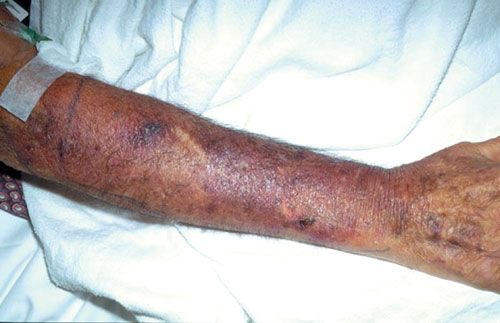- Clinical Technology
- Adult Immunization
- Hepatology
- Pediatric Immunization
- Screening
- Psychiatry
- Allergy
- Women's Health
- Cardiology
- Pediatrics
- Dermatology
- Endocrinology
- Pain Management
- Gastroenterology
- Infectious Disease
- Obesity Medicine
- Rheumatology
- Nephrology
- Neurology
- Pulmonology
Man With a Potentially Life-Threatening Waterborne Infection
A 79-year-old man presents to theemergency department with a painfullesion on his right forearm. Three daysearlier, he had scratched his arm whileremoving crabs from a trap. Initially,the scratch had bled slightly, and hehad self-treated with an over-the-counterantibiotic ointment and an adhesivebandage.

A 79-year-old man presents to the emergency department with a painful lesion on his right forearm. Three days earlier, he had scratched his arm while removing crabs from a trap. Initially, the scratch had bled slightly, and he had self-treated with an over-the-counter antibiotic ointment and an adhesive bandage.
The wound and surrounding area have become progressively inflamed and discolored and increasingly painful. The patient has also had fever and chills during the past 2 days.
This man has type 2 diabetes mellitus that is well controlled with insulin. He appears healthy, well-nourished, alert, and oriented. Vital signs are normal. There are no abnormal cardiac, pulmonary, or abdominal findings. An erythematous, violaceous lesion is noted along the length of the right forearm; a central abrasion with serous drainage is also present (Figure). Light palpation elicits significant pain.
A radiograph of the arm shows no evidence of osteomyelitis or gas in the soft tissue. The white blood cell count is 15,000/μL, and serum glucose level is 149 mg/dL; electrolyte levels are normal. Specimens are obtained from the abrasion and serous drainage for culture. Because of the patient’s contact with crabs and exposure to potential pathogens in brackish water, intravenous ceftazidime and doxycycline are started.
During the next 48 hours, the patient’s symptoms abate dramatically; the antibiotic regimen is changed to oral doxycycline. The cultures reveal Vibrio vulnificus sensitive to ceftazidime and doxycycline. The patient is discharged from the hospital and instructed to continue oral doxycycline for 21 days. At 1-month follow-up, the infection has completely resolved.
A POTENTIALLY FATAL INFECTION
V vulnificus infections are potentially fatal. To minimize morbidity and mortality, timely assessment and proper antibiotic treatment are required. Mortality among patients with frank
TREATMENT
V vulnificus is reliably susceptible to a variety of antibiotics. A good response can be anticipated with 2- drug therapy, which is usually a combination of a third- or fourth-generation cephalosporin (such as ceftazidime) and doxycycline or minocycline. 4 Broad-spectrum dual-agent treatment can minimize the risk of an adverse outcome while pathogen identification and susceptibility testing are completed.5 Recent in vitro studies have shown single-agent treatment with a newer fluoroquinolone to be as effective as the cephalosporin/ doxycycline 2-drug combination.5 However, further clinical evaluations and validations of the single-agent regimens are needed.5
In addition to antimicrobial therapy, surgical debridement of devitalized, infected tissue plays a pivotal role in successful treatment of V vulnificus infections.6 Debridement is usually performed when the tissue is bullous or devitalized or when an abscess has formed.
KEY POINTS FOR YOUR PRACTICE
V vulnificus infections frequently represent rapidly escalating, potentially fatal scenarios. To improve the likelihood of early recognition and successful resolution of the infection, keep these tips in mind:
- Be alert for wounds that rapidly become inflamed, discolored, and painful.
- Take a precise exposure history. Ask whether patients have been exposed to brackish or salt water or have ingested raw seafood. This is particularly important in those who are immunocompromised or have underlying liver disease.
- Consider unfavorable host factors, such as diabetes; excessive alcohol use; and underlying liver disease, including chronic hepatitis B or hepatitis C.
References:
REFERENCES:
1.
Chuang YC, Yuan CY, Liu CY, et al.
Vibrio vulnificus
infection in Taiwan: report of 28 cases and review of clinical manifestations and treatment.
Clin Infect Dis.
1992;15:271-276.
2.
Morris JG Jr, Black RE. Cholera and other vibrioses in the United States.
N Engl J Med.
1985;312:343-350.
3.
Wickboldt LG, Sanders CV.
Vibrio vulnificus
infection. Case report and update since 1970.
J Am Acad Dermatol.
1983;9:243-251.
4.
Tang HJ, Chang MC, Ko WC, et al. In vitro and in vivo activities of newer fluoroquinolones against
Vibrio vulnificus
Antimicrob Agents Chemother.
2002;46:3580-3584.
5.
Keusch GT, Waldor MK. Cholera and other vibrioses. In: Braunwald E, Fauci AS, Kasper DL, et al, eds.
Harrison's Principles of Internal Medicine.
New York: McGraw-Hill; 2001:980-985.
6.
Penman AD, Lanier DC Jr, Avara WT 3rd, et al.
Vibrio vulnificus
wound infections from the Mississippi Gulf coastal waters: June to August 1993.
South Med J.
1995;88:531-533.
